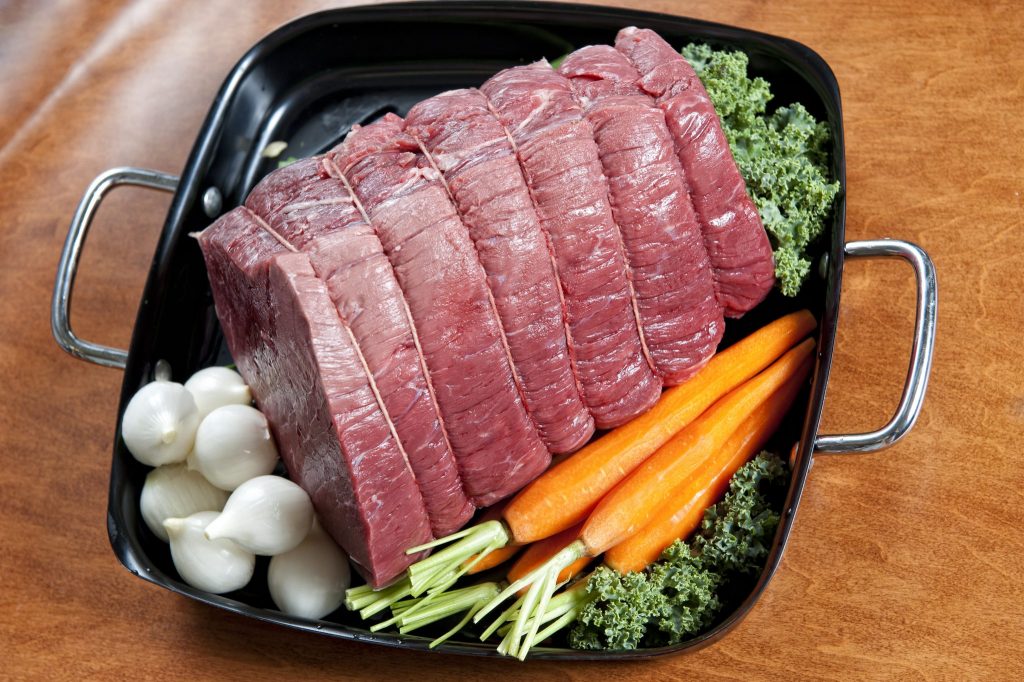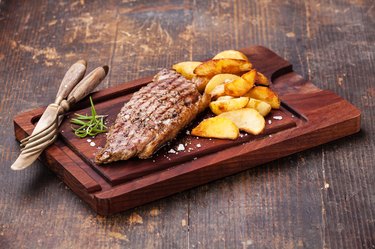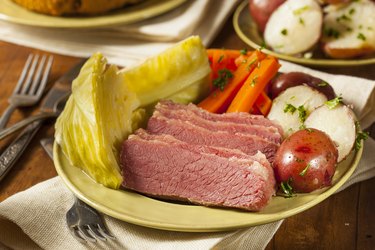It is possible to make a tasty roast beef dinner with a cheaper cut of beef, like baron of beef. You can slow-cook roast beef in the oven or a slow cooker. The meat gets tender and flavorful after a long time of cooking at a low temperature.
Place baron of beef in the oven and season it with a dry rub. Then, brown it on all sides. Start it cooking in the oven at 250 degrees Fahrenheit and finish it at 550 F.
Baron of beef is a classic roast that can be the centerpiece of a delicious meal, but its name may leave many home cooks wondering – what kind of cut is it? This tender, flavorful roast comes from the beef chuck primal cut and has many aliases, including London broil, top sirloin roast, and center cut roast Understanding the baron of beef and how to cook it opens up possibilities for creating incredible dinners.
Where Does Baron of Beef Come From on the Cow?
To understand this roast it helps to visualize where it comes from on the animal. Baron of beef is cut from the chuck primal – the shoulder region of the cow. More specifically, it comes from the chuck roll which sits above the shoulder blade.
Within the chuck roll are several muscles including the serratus ventralis, splenius, rhomboideus, and longissimus dorsi. The longissimus dorsi muscle tends to be the most tender, while the other muscles have more connective tissue. Baron of beef showcases meat from all these muscles.
Why the Names London Broil and Top Sirloin Roast?
This cut goes by several aliases that can cause confusion. London broil and top sirloin roast are two common alternate names.
London broil arose as a way of merchandising the cut at butcher shops. It refers to preparing the roast using a marinade or seasoning blend followed by quick, hot cooking to rare or medium doneness.
Top sirloin roast denotes where the cut came from, high up on the sirloin close to the round primal. It distinguishes the baron from the bottom sirloin butt roast lower on the sirloin primal
Key Characteristics of Baron of Beef
Understanding the qualities of this cut helps cooks select the best methods for preparation. Here are the notable attributes of baron of beef:
-
Tenderness – While not as tender as cuts like tenderloin or ribeye, baron has moderate tenderness when roasted. It should be cooked to a doneness below well-done to prevent toughening.
-
Flavor – With various muscles involved, baron offers full, beefy flavor. Any seasonings or sauces nicely complement the taste.
-
Fat – Baron has rich marbling and fat cap that keeps the meat juicy when roasted. Trimming some excess fat prevents greasiness.
-
Shape – Baron of beef takes an oblong, tapered shape allowing for attractive carving into slices.
-
Versatility – This cut works well for roasting, grilling, braising, and slicing for stir-fries or sandwiches.
-
Affordability – As a chuck cut, baron costs less than loin cuts like rib roast or strip roast. Its great flavor at a lower cost makes baron a smart choice.
How to Cook Baron of Beef for Best Results
Baron’s versatility means many cooking methods yield delicious results. For optimal tenderness and juiciness, opt for these preparation techniques:
-
Roasting – The preferred cooking method. Sear the roast then finish roasting in a 325°F oven until it reaches an internal temperature of 135°F for medium-rare. Let rest before slicing across the grain.
-
Grilling – Works beautifully when sliced into 1-inch steaks. Use medium-high heat and grill to desired doneness, about 4 minutes per side for medium-rare.
-
Braising – Cut baron into 2-inch chunks, brown them, then braise in flavorful liquid for ultimate tenderness.
-
Broiling – Great for London broil recipes. Broil on high, 4-5 minutes per side until rare or medium-rare. Slice thinly across the grain.
-
Stir-frying – When sliced very thinly against the grain, baron can be stir-fried in a hot pan or wok. Cook just until no longer pink.
Seasoning and Sauce Ideas for Baron of Beef
The beefy flavor of baron pairs wonderfully with all types of seasonings. Consider these options:
- Herb rubs – blends using rosemary, thyme, oregano, garlic, pepper
- Spice rubs – chili powder, smoked paprika, cumin, chipotle, mustard
- Umami flavors – soy sauce, Worcestershire, mushrooms, red wine
- Marinades – balsamic, wine, citrus, ginger, herbs
- Sauces – chimichurri, barbecue sauce, gravy, horseradish cream
Experiment with global seasonings like ras el hanout, jerk seasoning, or five spice powder. The possibilities are endless!
What to Serve with Baron of Beef
Finding the right side dishes elevates a meal. Here are smart pairings with baron of beef:
- Roast vegetables – potatoes, carrots, parsnips, Brussels sprouts
- Rice pilaf or roasted sweet potatoes
- A fresh salad or roasted asparagus
- Yorkshire pudding or popover rolls
- Pan sauces made from the roast drippings
For special occasions, try baron of beef with roasted root vegetables or scalloped potatoes along with a red wine pan sauce or horseradish cream.
Buying and Storing Baron to Maximize Freshness
A few tips ensure your baron of beef is the freshest for cooking:
- Look for a cut with good marbling and a thick layer of fat on one side
- Approximate size should be 3 to 4 pounds to serve 4 to 6 people
- Store tightly wrapped in the refrigerator for up to 4 days
- Let the roast sit at room temperature for 1 hour before cooking
- For longer storage, freeze well-wrapped for 4 to 6 months
When handled properly, this versatile cut delivers a fabulous meal. With an understanding of the baron of beef roast, from its origin to ideal cooking methods, you can create incredible dinners. Experiment with different seasoning blends and side dishes for an unforgettable dining experience.

About Baron of Beef
Other names for baron of beef include top sirloin, top butt and center-cut roast. Steamship round, which comes from the rump, also falls into this category. Even though baron of beef is tasty and tender, it’s not as tender or cheap as meat from the rib or loin.
Video of the Day
Prime rib refers to sliced portions from a ribeye or a beef rib roast after its cooked, says the University of Nebraska-Lincoln. The term “prime” also denotes a grade of beef from young, well-fed cattle. Its costly and is richly marbled with fat.



While prime rib is normally sold in restaurants, it isnt needed to make a delicious roast. Cuts of meat for roasting that are typically found in supermarkets are “choice grades,” which are very tasty.
You can dry roast cheaper cuts of meat, like baron of beef, in the oven at lower temperatures and for longer periods of time than rib roasts. You can also roast them using the moist-heat method, which involves browning them first and then cooking them with extra liquid in an oven or stove pot with a tight lid.
Slow Cook Baron of Beef
Alejandro Benes, culinary director of the restaurant group Wood Ranch, provides this recipe to slow-cook roast beef in the oven. It should be easy to follow at home.



In the first step, Benes recommends aging the beef. First, put the roast on a wire rack on a sheet pan. Then, leave it in the fridge for four days without covering it.
“Mix onion powder, garlic powder, chili powder, paprika for color, and a lot of brown sugar to make a dry rub.” This will help build a crust on the roast,” he says. For a 5-pound roast, use 2 to 3 tablespoons of each ingredient.
Next, sear the roast in a pan with a little oil. Brown all sides to build a layer of flavor. “This step is very important for getting a tasty result when cooking in a dry place like the oven,” Benes says.
Preheat the oven to 250 F. “This might seem low, but it will help get a tender result. “Be patient with the cooking because most of these cuts have limited marbling, which is fat inside the muscle, so it’s best to be patient,” he says.
Place the roast on the middle rack of the oven. The fat side should be on top. The roast should be no more than 110 F on the inside. Then raise the oven temperature to 550 F. This will help reinforce the exterior of the meats crust. Cook until you reach the desired internal temperature,” Benes advises. Generally, the roast will take 20 minutes per pound to cook.
This recipe goes well with horseradish or mustard, but you can make a gravy from the pan juices if you want to.
An alternative to cooking roast in the oven is to prepare it in a slow cooker. It says that if you want to make slow-cooker roast beef, you should use chunks of meat instead of big cuts. Put the heat on high for an hour, and then cook on low until done. Only use recipes that call for some kind of liquid such as bone broth. Make sure the internal temperature of the meat reaches 140 F. Dont use a slow cooker to reheat the roast.
How to Choose a Pot Roast
FAQ
What is another name for baron of beef roast?
What are beef barons?
Where is the baron of beef cut from?
How many people does a baron of beef feed?
What is a baron of beef?
The Baron of Beef is a cut of beef that comes from the top round of the cow. It is a large cut, typically weighing between 100 to 200 pounds, and is known for its rich flavor and tenderness. While some people in North America may refer to an extremely large cut from the back end of the cow as a Baron of Beef, this is not the traditional definition.
What is the difference between a baron of beef and other cuts?
Caterers for large groups are clear on the difference between a Baron of Beef and other cuts, as they charge more for it due to its inclusion of sirloin. Other names for this cut include top sirloin, top butt, center-cut roast, and London broil.
How to prepare a baron of beef roast?
To prepare a delicious baron of beef roast, it is important to start with a high-quality cut of meat. It is typically best to choose a cut that has a good amount of marbling to ensure a juicy and flavorful roast.
What does Baron of beef taste like?
The Baron of Beef is known for its savory, juicy, and slightly sweet flavor profile. It has a rich taste that is not as tender or as expensive as other cuts of meat from the rib or loin areas.
